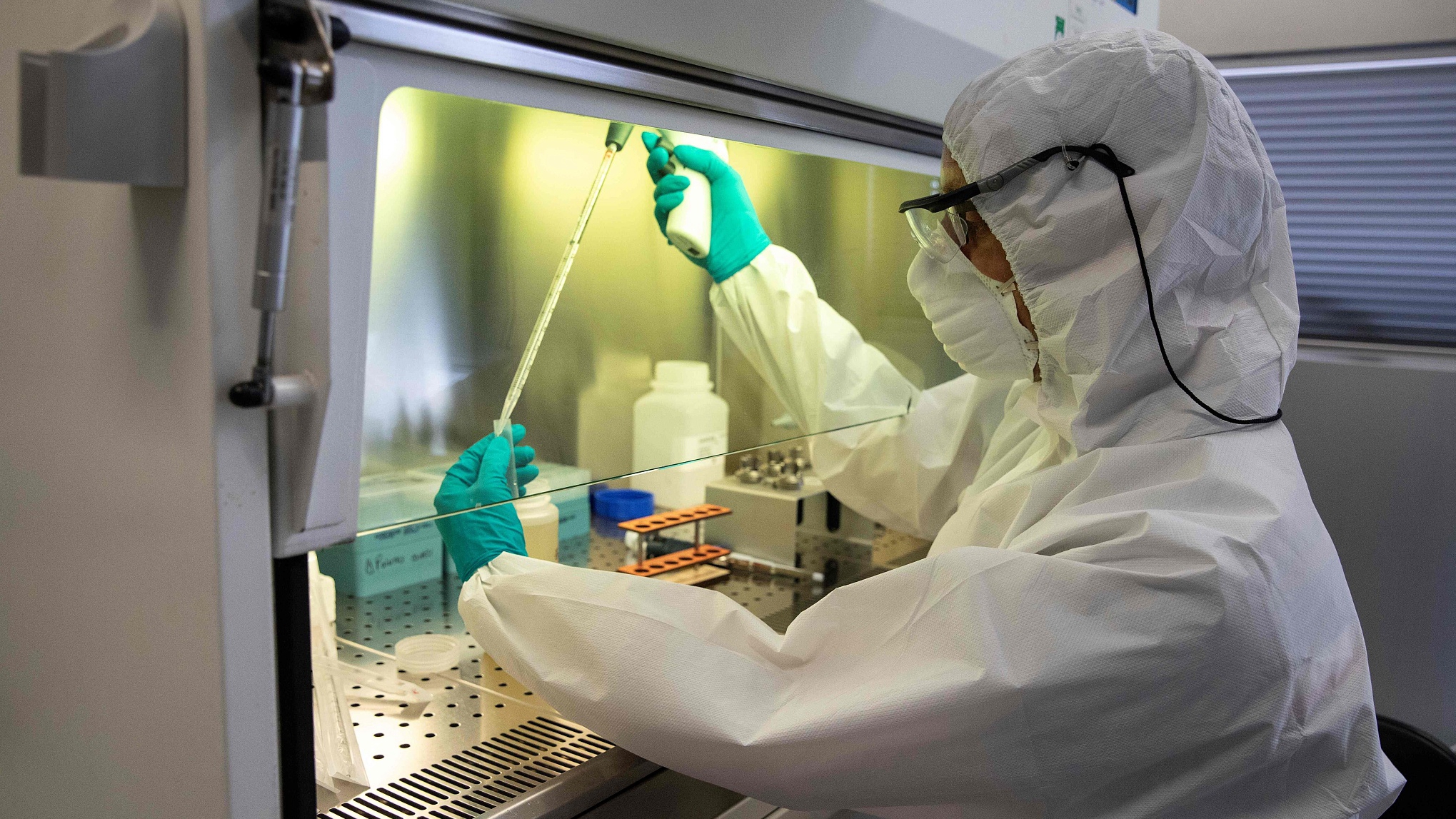Editor's note: Anthony Moretti is an associate professor at the Department of Communication and Organizational Leadership of Robert Morris University in Pittsburgh, Pennsylvania. The article reflects the author's views and not necessarily those of CGTN.
Chances are you have never met Dr. Danielle Anderson. But should you ever have that opportunity, you want to pay close attention to what the Australian scientist says. I will summarize in just a few words: The "lab-leak" theory being floated in the West, and especially in the U.S., to explain the beginning of the coronavirus pandemic almost certainly is a bunch of baloney.
At this point, some critics who are reading this and thinking "sure, Anderson must be some lackey who is doing Beijing's bidding as she hides behind her education degree."
I will summarize that opinion in just a few words: That is definitely a bunch of baloney.

A virologist tests wastewater in Paris, France to detect the presence of the COVID-19 virus, July 22, 2020. /CFP
A virologist tests wastewater in Paris, France to detect the presence of the COVID-19 virus, July 22, 2020. /CFP
Dr. Anderson not only understands science -- she has been identified by Bloomberg as a "rising star in the virology community" -- but more importantly she was the only non-Chinese scientist working at the Wuhan Institute of Virology lab throughout 2019. And in a wide-ranging interview with Bloomberg, she makes it very clear that the professionalism of her Chinese colleagues throughout her time in Wuhan was top notch.
"What people are saying is just not how it is," she said, as she discussed the allegations of slipshod research and safety practices being directed at scientists in Wuhan, all of whom are therefore considered suspect in the eyes of many Western politicians. As you know, the Western narrative is "maybe, just maybe, a scientist inside the institute accidentally (or even more ominously, intentionally!) released the virus into Wuhan, from where it rapidly spread around the world." One U.S. newspaper has attempted to advance that theory by claiming at least three scientists working inside the lab were hospitalized in November 2019.
In response, Dr. Anderson told Bloomberg, "If people were sick, I assume that I would have been sick—and I wasn't." She added that she was "tested for coronavirus in Singapore," where she traveled immediately after leaving China, before she received a vaccine and at no point became ill.
Dr. Anderson left Wuhan in late 2019 (after her stay associated with a grant came to an end), and about a month later she was at an international conference. While there, she noted that no one was discussing whether any Chinese scientists were ill for reasons that could not be explained.
"Scientists are gossipy and excited," Dr. Anderson said. "There was nothing strange from my point of view going on at that point."
Dr. Anderson's story is relevant for a rather simple reason: She was in Wuhan during one of the most scrutinized periods of the investigation into how the virus began infecting China and then the world. She becomes the latest -- and without a doubt most important -- source saying the criticism directed at the Chinese lacks common sense.

A healthcare worker takes a swab sample of a traveller to test for coronavirus infection, at Dadar station in Mumbai, India, January 28, 2021. /Getty Images
A healthcare worker takes a swab sample of a traveller to test for coronavirus infection, at Dadar station in Mumbai, India, January 28, 2021. /Getty Images
Recent support for the Chinese began with a letter, dated May 13, and signed by almost 20 prominent scientists from multiple nations. They reminded everyone of the conclusion from the intense initial investigation into what caused coronavirus to spread globally: An animal, more specifically a bat, was "likely to very likely" responsible.
About one month later, one of the scientists involved in that investigation wrote in the Guardian that animals had been the "likely source" of every virus that has spread around the world over the past 50 years. Dr. Dominic Dwyer suggested human error would be possible in Wuhan only if "there had been a breakdown of usual regulated laboratory procedures around sample collection and preparation."
And what does Dr. Anderson think of the potential for human error? Suffice to say, in her opinion, everything that happened inside the lab met the highest international standards, and there was strict attention to detail. Bloomberg reported she was "impressed" by the lab, which has "the highest bio-safety designation, and requires air, water and waste to be filtered and sterilized before it leaves the facility." She added that researchers were required to complete more than 40 hours of training before they were allowed to work inside the Wuhan lab.
According to Bloomberg, Dr. Anderson said walking into or out of the facility involved detailed steps. The process of exiting the lab was described as a "carefully choreographed endeavor," which required the person to take "both a chemical shower and a personal shower," both of which were "precisely planned."
I encourage you to strongly consider what Dr. Anderson is saying, because she is considered the ideal source for U.S. journalists, no matter the story they are reporting: an expert and also an eyewitness.
You cannot undermine her academic credentials. You cannot undermine what she experienced inside China. You cannot undermine her confidence that resonates as you read the account Bloomberg has posted on its website. If Dr. Anderson were testifying in a U.S. courtroom, she would be one of the strongest witnesses in the case.
That is definitely no baloney.
(If you want to contribute and have specific expertise, please contact us at opinions@cgtn.com.)

